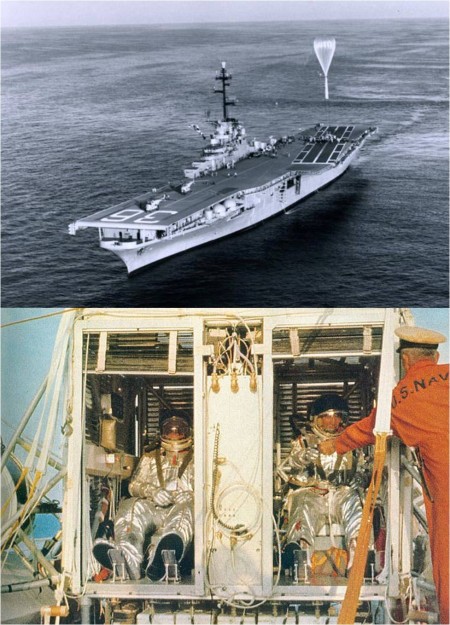Fifty-one years ago this month, the United States Navy Strato Lab V manned balloon soared to a record altitude of 113,740 feet above the Gulf of Mexico. The crew for this historic flight was Commander Malcolm D. Ross, USNR and Lt Commander Victor G. Prather, USN.
Strato Lab was a United States Navy program to scientifically explore the upper reaches of the stratosphere using manned balloons. An additional focus of the program was the acquisition of aero medical data in support of the United States man-in-space effort.
A total of five (5) Strato Lab balloon flights took place from 1956 to 1961. Each Strato Lab mission was flown by a two-man crew with Malcolm Ross as the flight commander. The Strato Lab I, II, III, and IV aerial excursions attained maximum altitudes between 76,000 and 86,000 feet.
Strato Lab V, which took place on Thursday, 04 May 1961, achieved the highest altitude (113,740 feet) of the program. The purpose of this flight was to perform a maximum test of the Navy’s Mark IV full-pressure suit. As such, Ross and Prather flew in an open gondola with nothing save their individual Mark IV suits providing protection from the space-equivalent environment at high altitude.
Launch took place from the USS Antietam (CV-36) stationed out in the Gulf of Mexico. The size of the Strato Lab V balloon was truly immense. It sported a volume of 10,000 million cubic feet and measured 300 feet in diameter at float altitude. Despite extreme cold and various technical problems, the crew successfully made the trip upstairs in about two and a half hours.
Ross and Prather were sobered by the view they had of earth and space as well as the realization that no person had ever seen either from such a vantage point. They did not linger long before starting the trip home. Descent was largely uneventful. Splashdown occurred within a mile and a half of the USS Antietam. Mission time was 9 hours and 54 minutes.
As they waited for helicopter pick-up, the crew savored their safety, the success of their mission and the outstanding performance of the Mark IV full-pressure suit. Malcolm Ross was the first to be picked-up by the recovery helicopter. With some difficulty, he was safely retrieved from the water-borne Strato Lab V gondola.
Then tragedy struck suddenly and irrevocably as Prather was being hoisted into the helicopter. The naval officer slipped from the retrieval sling and fell into the water. Divers in the helicopter quickly jumped into the ocean in an effort to save Prather. Despite their rapid response, Victor Prather drowned. Ironically, the Mark IV suit, which just hours before had preserved life, now took that life away as it filled rapidly with sea water and dragged Prather below the surface.
For their significant efforts, Ross and Prather (posthumously) were awarded the 1961 Harmon Trophy for Aeronauts. The performance of the Mark IV suit was so outstanding that it served as the basis for the Project Mercury spacesuit. Interestingly, the day after the Strato Lab V mission, USN Commander Alan Bartlett Shepard became the first American in space during the sub-orbital flight of Freedom 7.

